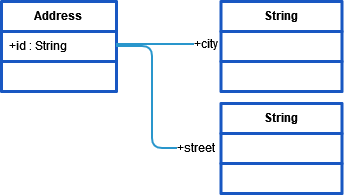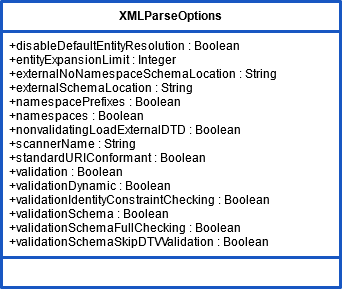|
Syntax |
|
|
|---|---|---|
|
Semantics |
The operation takes an XML buffer as blob ( By default the following mapping rules apply:
These default rules can be overridden by using the stereotypes XMLElement, XMLAttribute, and XMLCharacters on class properties.
Frequently, an XML document is given as a string instead of a blob. In such cases, it is possible to apply |
|
|
Substitutables |
|
Can be any variable or object attribute having the type Blob. |
|
|
Target object, can be any object. |
|
|
Error Codes |
Find the related error codes on Log Errors of domain XMLLM. |
|
|
|
The native XML parser reported a fatal error during parsing. Read more on Troubleshooting the XML Serialization for more information if you cannot resolve such errors. |
|
|
Examples |
The action script below creates an object of type Address. An output object named myAddress of type Address needs to be defined. Beneath, a sample XML document is shown to illustrate the executed mapping. The XML document is mapped to an instance of Address as shown in the class diagram. XML Source XML
Target Class Structure 
Note, that the XML element myAddress is mapped to the object myAddress, which is of type Address. This type has the UML attribute id which corresponds to the XML attribute id. Additionally, the XML elements street and city are mapped to the association ends city respectively street. Both are having the type String. |
|
XML Parsing Options (Validation against a Schema)
xmlToClass() offers an optional parameter of type XMLParseOptions. It has various attributes to control schema and DTD location and validation:

Be aware that by default, schemas are parsed, but documents are not validated against them. Set the validation attribute to true if you want to enforce validation beyond well-formedness.
For example, assume that you want to validate your document against a schema called CustomerData.xsd having the namespace http://acme.com/customer. In this case, you need to set the following parse options:
|
Option |
Value |
|---|---|
|
externalSchemaLocation |
http://acme.com/customer |
|
validation |
true |
If the XML document refers a schema file (.xsd) with filename (and optional path), it is sufficient to upload the file to the Integration (Bridge) as a resource. It will be automatically loaded from there.
If the XML document refers no schema, or you would like to provide another than the referred one, use the XMLParseOptions structure and set externalSchemaLocation (or externalNonamespaceSchemaLocation) accordingly. As above, missing or relative paths will be redirected to the resource folder of the Integration (Bridge). The same applies also for validating against DTDs. Be aware that validation is turned off by default (see option validation below).
The following table lists all available XML options. Default values used when an option is not explicitly set are written in bold. The Runtime uses the Xerces parser internally, so you can find more information for all options on the Xerces home page by following the link in the Xerces column.
|
Parse Option |
Description |
Xerces Link |
Values |
|
|---|---|---|---|---|
|
validation |
Controls validation. |
true |
Report all validation errors. The document must specify a grammar in this case. This option overrides nonvalidatingLoadExternalDTD. |
|
|
false |
Do not report validation errors (default).
|
|||
|
validationDynamic |
Validate the document if a grammar is specified. |
true |
The parser will validate the document only if a grammar is specified. (validation must be true). |
|
|
false |
Validation is determined by the state of the validation option (default). |
|||
|
validationSchema |
Control schema support. |
true |
Enable the parser's schema support (default).
|
|
|
false |
Disable the parser's schema support. |
|||
|
validationSchemaFullChecking |
Enable checking the schema grammar itself for additional errors that are time-consuming or memory intensive. It does not affect the level of checking performed on document instances that use schema grammars. |
true |
Enable full schema constraint checking, including checks that may be time-consuming or memory intensive. Currently, particle unique attribution constraint checking and particle derivation restriction checking are controlled by this option. |
|
|
false |
Disable full schema constraint checking (default). |
|||
|
nonvalidatingLoadExternalDTD |
Controls loading an external DTD. This feature is ignored and DTD is always loaded when the option validation is true. |
true |
Load external DTD. |
|
|
false |
Ignore external DTD completely (default). |
|||
|
standardURIConformant |
Controls standard URI checks. |
true |
Force standard URI conformance. Malformed URIs will be rejected. |
|
|
false |
Do not force standard URI conformance (default). |
|||
|
validationIdentityConstraintChecking |
Controls entity constraint checking. |
true |
Enable identity constraint checking (default). |
|
|
false |
Disable identity constraint checking. |
|||
|
validationSchemaSkip-DTDValidation |
Controls usage of DTDs. |
true |
When validationSchema is true the parser will ignore the DTD, except for entities. |
|
|
false |
The parser will not ignore DTDs when validating (default). |
|||
|
disableDefaultEntityResolution |
Controls entity resolution. |
true |
The parser will not attempt to resolve the entity if the Runtime can't find it. |
|
|
false |
The parser will attempt to resolve the entity on its own if the Runtime can't find it (default). |
|||
|
namespaces |
Controls namespace processing. If the validation option is set to true, then the document must contain a grammar that supports the use of namespaces. |
true |
Perform namespace processing (default). |
|
|
false |
Do not perform namespace processing. |
|||
|
namespacePrefixes |
Controls reporting of namespace prefixes. |
true |
Report the original prefixed names and attributes used for namespace declarations. |
|
|
false |
Do not report attributes used for namespace declarations, and optionally do not report original prefixed names (default). |
|||
|
externalSchemaLocation |
The XML Schema Recommendation explicitly states that the inclusion of schemaLocation/nonamespaceSchemaLocation attributes in the instance document is only a hint; it does not mandate that these attributes must be used to locate schemas. Similar situation happens to <import> element in schema documents. This property allows the user to specify a list of schemas to use. If the targetnamespace of a schema specified using this method matches the targetnamespace of a schema occurring in the instance document in schemaLocation attribute, or if the targetnamespace matches the namespace attribute of <import> element, the schema specified by the user using this property will be used (i.e., the schemaLocation attribute in the instance document or on the <import> element will be effectively ignored). |
The syntax is the same as for schemaLocation attributes in instance documents: e.g, "http://www.acme.com file_name.xsd". The user can specify more than one XML Schema in the list. |
||
|
externalNonamespaceSchemaLocation |
The XML Schema Recommendation explicitly states that the inclusion of schemaLocation/nonamespaceSchemaLocation attributes in the instance document is only a hint; it does not mandate that these attributes must be used to locate schemas. This property allows the user to specify the no target namespace XML Schema Location externally. If specified, the instance document's nonamespaceSchemaLocation attribute will be effectively ignored. |
The syntax is the same as for the nonamespaceSchemaLocation attribute that may occur in an instance document: e.g."file_name.xsd". |
||
|
scannerName |
This property allows the user to specify the name of the XMLScanner to use for scanning XML documents. |
The recognized scanner names are: |
||
|
WFXMLScanner |
A scanner that performs well-formedness checking only. |
|||
|
DGXMLScanner |
A scanner that handles XML documents with DTD grammar information. |
|||
|
SGXMLScanner |
A scanner that handles XML documents with XML schema grammar information. |
|||
|
IGXMLScanner |
A scanner that handles XML documents with DTD or/and XML schema grammar information (default). |
|||
|
entityExpansionLimit |
To mitigate an entity expansion attack (aka "XML bomb" or "the billion laughs" attack) you use this tagged value to limit entity expansion to the specified level. |
|
Any integer, no default. If using this tagged value, provide at least value 1. Otherwise the standard XML entities will not be parsed. |
|
